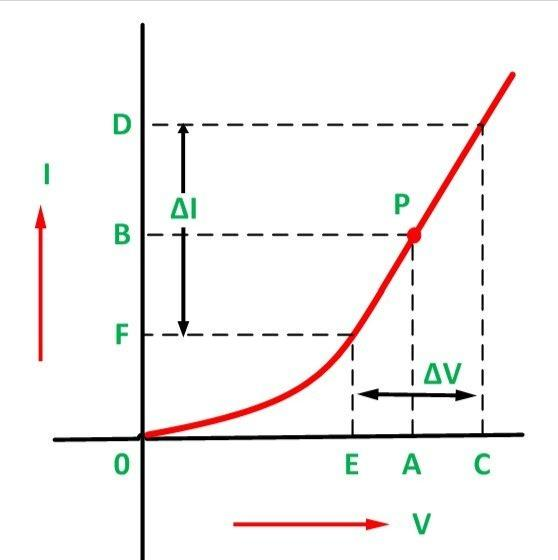
The change in current through a junction diode is \[1.2mA\] when forward bias voltage is changed by \[0.6V\].The dynamic resistance is
\[\begin{align}
& A.500\Omega \\
& B.300\Omega \\
& C.150\Omega \\
& D.250\Omega \\
\end{align}\]
Answer
543.9k+ views
Hint: Dynamic resistance is also known as AC resistance, as typical resistance formula, it depends on change in current and voltage. Here, we take these from the operating point q in the V-I characteristics of a diode. For every small change in voltage it experienced a large change in current.
Formula used:
\[{{r}_{dynamic}}=\dfrac{\Delta V}{\Delta I}\]
Complete answer:
As we know about resistance, it is the opposing force against flow of current. In case of a diode there are 2 types of resistances. Static and dynamic. Static resistance is the resistance when the diode is applied to DC and Dynamic resistance is the resistance offered by the diode when AC is applied. It is also known as AC resistance.
When we examine the V-I characteristics of p-n junction diode as shown in the picture,

The ratio of change in voltage \[\Delta V\] to the change in current \[\Delta I\] represents dynamic resistance.
I.e., \[{{r}_{dynamic}}=\dfrac{\Delta V}{\Delta I}\]
In the question, it is given that,
Change in voltage, \[\Delta V=0.6V\]and Change in current,\[\Delta I=1.2mV\]
\[\begin{align}
& \Rightarrow {{r}_{dynamic}}=\dfrac{0.6V}{1.2mA} \\
& \\
\end{align}\]
\[\begin{align}
& {{r}_{dynamic}}=\dfrac{0.6}{1.2}\times {{10}^{3}} \\
& {{r}_{dynamic}}=\dfrac{600}{1.2}=500\Omega \\
& \\
\end{align}\]
So, we found that the dynamic resistance of the diode at the given voltage is \[500\Omega \]
Therefore, the correct answer is option A .
Note:
We can also do the dynamic resistance problem only by knowing diode current too. The formula is given as,
\[\begin{align}
& \dfrac{\Delta {{V}_{d}}}{\Delta {{I}_{d}}}=\dfrac{\eta {{V}_{t}}}{{{I}_{d}}} \\
& \Rightarrow {{r}_{d}}=\dfrac{26mV}{{{I}_{d}}} \\
\end{align}\]
Here, \[{{I}_{d}}\] is the diode current and \[\eta {{V}_{t}}\] is equal to \[26mV\]
This formula is derived from the diode current equation, \[{{I}_{d}}={{I}_{s}}({{e}^{\dfrac{{{V}_{d}}}{\eta {{V}_{t}}}}}-1)\].
Formula used:
\[{{r}_{dynamic}}=\dfrac{\Delta V}{\Delta I}\]
Complete answer:
As we know about resistance, it is the opposing force against flow of current. In case of a diode there are 2 types of resistances. Static and dynamic. Static resistance is the resistance when the diode is applied to DC and Dynamic resistance is the resistance offered by the diode when AC is applied. It is also known as AC resistance.
When we examine the V-I characteristics of p-n junction diode as shown in the picture,

The ratio of change in voltage \[\Delta V\] to the change in current \[\Delta I\] represents dynamic resistance.
I.e., \[{{r}_{dynamic}}=\dfrac{\Delta V}{\Delta I}\]
In the question, it is given that,
Change in voltage, \[\Delta V=0.6V\]and Change in current,\[\Delta I=1.2mV\]
\[\begin{align}
& \Rightarrow {{r}_{dynamic}}=\dfrac{0.6V}{1.2mA} \\
& \\
\end{align}\]
\[\begin{align}
& {{r}_{dynamic}}=\dfrac{0.6}{1.2}\times {{10}^{3}} \\
& {{r}_{dynamic}}=\dfrac{600}{1.2}=500\Omega \\
& \\
\end{align}\]
So, we found that the dynamic resistance of the diode at the given voltage is \[500\Omega \]
Therefore, the correct answer is option A .
Note:
We can also do the dynamic resistance problem only by knowing diode current too. The formula is given as,
\[\begin{align}
& \dfrac{\Delta {{V}_{d}}}{\Delta {{I}_{d}}}=\dfrac{\eta {{V}_{t}}}{{{I}_{d}}} \\
& \Rightarrow {{r}_{d}}=\dfrac{26mV}{{{I}_{d}}} \\
\end{align}\]
Here, \[{{I}_{d}}\] is the diode current and \[\eta {{V}_{t}}\] is equal to \[26mV\]
This formula is derived from the diode current equation, \[{{I}_{d}}={{I}_{s}}({{e}^{\dfrac{{{V}_{d}}}{\eta {{V}_{t}}}}}-1)\].
Recently Updated Pages
A man running at a speed 5 ms is viewed in the side class 12 physics CBSE

The number of solutions in x in 02pi for which sqrt class 12 maths CBSE

State and explain Hardy Weinbergs Principle class 12 biology CBSE

Write any two methods of preparation of phenol Give class 12 chemistry CBSE

Which of the following statements is wrong a Amnion class 12 biology CBSE

Differentiate between action potential and resting class 12 biology CBSE

Trending doubts
What are the major means of transport Explain each class 12 social science CBSE

Which are the Top 10 Largest Countries of the World?

Draw a labelled sketch of the human eye class 12 physics CBSE

Explain sex determination in humans with line diag class 12 biology CBSE

Explain sex determination in humans with the help of class 12 biology CBSE

Differentiate between homogeneous and heterogeneous class 12 chemistry CBSE




